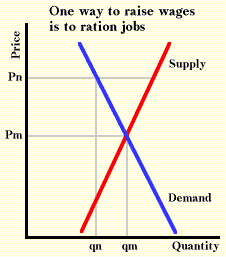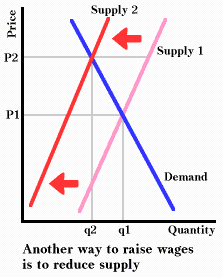Restrictions in The Labor Market
Important cases of restrictions that are designed to increase price occur in the resource market. Suppose all workers band together in a union and refuse to work except at the wage rate Pn in the graph below. They will get a higher wage but they also will create a surplus of unemployed workers. Because these workers want to work, they could undermine worker unity. This problem is avoided when workers organized only in some industries, not all of them.
When workers organize in only some industries, the surplus workers have the option of moving to non-unionized industries to find work, so unionization no longer results in unemployment. Why does an employer agree to the higher wages? Could he avoid the increase by dismissing the unionized workers and replacing them with non-unionized workers? Dismissal of unionized or striking workers may be illegal or result in substantial legal costs. If the wage increase is not too great, it may be cheaper to pay the increase than to hire and train new workers when training costs are high. Historically, attempting to replace union workers has led to violence and destruction of property.

Not all labor markets can be illustrated with supply and demand. If the firm sees the labor supply curve as upward sloping, the firm is a price searcher, not a price taker. In this case the effect of the union could be both higher wages and increased employment. A firm is most likely to face an upward-sloping supply curve when it hires specialized workers that few other firms hire.
An alternative way to raise price is to restrict supply, an option that usually requires the cooperation of the government. A common way to restrict supply is with licensing. Fewer people will enter an occupation if they need a license and the number of licenses is limited or expensive to obtain. The graph below illustrates how this method works. Supply 1 is the supply curve without licensing and Supply 2 is the supply curve with it. Among the many occupations that use this method (the list varies from state to state) are teachers, most medical professions, lawyers, accountants, beauticians, barbers, morticians, and veterinarians.

For the use of resources to be efficient, their prices must reflect the value that they could contribute elsewhere in the economy. The price that a person using a resource sees should be the opportunity cost of that resource. The problem that licensing and union power cause is that they generate prices that misstate the opportunity costs of resources. When the cost of a resource that a decision maker uses differs from its social cost (which is its opportunity cost), decisions will be distorted and not economically efficient. For example, if a union contract says that an employer must pay Ian Segoe $10.00 per hour and Ian will only add value of $9.00, the firm will not hire him. If his next best option is a job that pays only $8.00 per hour, Ian's labor will not used where it adds the most value.
One might object to treating unions and professional licensing in the same way that monopolies are treated. Many people believe that labor unions aid working people and licensing protects the public. They believe that the extra wages that unions obtain for their members come from the profits of big business, and without licensing, the public would be exposed to charlatans.
Effective unions do raise the wages of their members. All economists who have studied the data seem to agree on this point, though they differ on how much unions raise wages of their members relative to those not in unions, with estimates ranging from 5% to 30%. These studies also suggest that the increase in wages for union members has the effect of pushing down wages in nonunionized sectors. The number of workers employed in an industry with successful unions will decrease. Thus, there will be more workers available in nonunionized sectors, causing supply curves to shift to the right. The equilibrium wage rate in the nonunionized sector will be lower as a result of unions.1
Licensing may improve the quality of services, but at the expense of reducing quantity. Hence, even if licensing achieves its stated purpose of improving quality, it is not necessarily true that the consumer is better off. The loss of cheap, low-quality service may offset the higher quality; would automobile drivers be better off if they could only buy Rolls-Royce automobiles? However, there is also considerable doubt on the part of some economists, based on their reading of the data, that licensing does much to improve quality.
Next we look at price discrimination, a pricing strategy that is widespread because it can be profitable.
1 Economic theory may encourage an underestimation of the value of unions because it focuses on relationships of voluntary exchange, not on power relationships. In a modern economy market relations have been partially replaced by the hierarchical relations within the large corporation. There is a potential for abuse in the power relations that exist within the firm, and unions are a way to respond to this. Unions are more likely to be formed in organizations that have poor management-worker relations than in those where management-worker relations are harmonious.
Copyright Robert Schenk